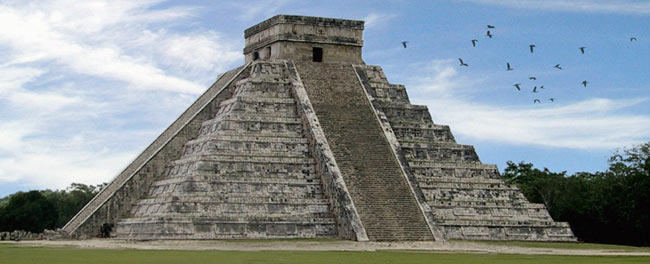These are descendants of the Mayans! How could this society fall so far from
ancient splendor to such a long list of modern woes? It is a question worthwhile for U.S. citizens
to ponder, because in the answers there might be some valuable insight for our
future.

About a thousand
years ago the Mayans had achieved impressive economic, political and social heights. At the empire’s peak strength, the Mayans had built more
than forty cities across Central America and reached a population in excess of
two million. The Mayan calendar was one
of their most shining accomplishments, based on an impressive understanding of
mathematics and astronomy.
The Mayans were doers
as well, designing and constructing large structures such as astronomical observatories
and religious temples for the thinkers and palaces and sports arenas for the
powerful. They also built elevated roads
between cities and elaborate subterranean aqueducts for water management and
irrigation. Their fields produced a wide
selection of food and textile crops. Do
not forget those playing balls produced long before Europeans even conceived of
rubber.

Unfortunately, even before the conquistadors sloshed ashore in the 16th Century with their lead shot and small-pox germs, the Mayan had experienced severe setback. Indeed, the Mayan economy may have been in tatters as early as the 8th Century. The Spanish found the Mayans living in small villages, eking out a living by hunting, fishing and growing a few garden vegetables.
Using vegetation
studies, NASA’s Goddard Institute for Space Studies developed a view on what
might have triggered the Mayan demise or at least hurried it along. The Mayans were farmers and cleared vast
areas of the tropical rainforest in Central America to build their agricultural
complex. Unfortunately, the loss of tree
cover may have worsened drought conditions by reflecting energy back into the
atmosphere rather than absorbing it.
With less energy captured on land there was less water vapor to form
clouds and then rain. Drought conditions intensified.
:max_bytes(150000):strip_icc()/Palenque-aqueduct-56a026195f9b58eba4af2556.jpg)
Mayan farm practices may have also played a role. They used slash and burn techniques and, in order to deliver enough food for the fast growing population, they were dependent upon securing large swathes of forest to clear. As forested areas near their cities were used up they may have had to shorten fallow cycles in old fields. Inadequate fallow time means depleted soils and reduced crop yields. The Mayans may have also experienced widespread corn crop failures due to mosaic virus. Notably, lengthy fallow times are needed to thwart the mosaic virus, which is spread by aphids.
Drought. Climate shifts. Nasty crop disease. Inept farming practices. The fields ultimately produced less food and
fiber than was needed for the prodigious population. The Mayan economy collapsed.
It would seem we
are not the first to grapple with the challenges of climate change. Mayans dealt with the climate problems of
their time with a tried and proven response
- pack the bags and move! The Mayans of the southern lowland region
left their big stone palaces and temples behind and hit the road for better
farmland to the north. The drought
followed them. Sound familiar?
There is one
other common element in the Central America stories. The ancient Mayans were plagued with fighting
not unlike the gang wars in the barrios of Guatemala and Honduras today. Ancient Mayans were known to be a civilized,
peaceful society. However, rival tribes
and neighboring cities had their disagreements too. Archaeological artifacts reveal a
military class and plenty of weaponry.
Economic failures may have exacerbated
political rivalries, intensifying fighting and violence. That
might sound familiar too.
The Trump
administration has described the Central American migrant caravan in terms of
race and crime. This xenophobic view sidesteps
what is most likely driving those poor wretches northward -
climate change economics. Central
American has taken some climate hits in recent years -
exceptionally strong hurricanes, severe drought, mudslides and rising
sea levels. Weather events destroy
valuable infrastructure, disrupt efficient supply chain function, eliminate businesses
and jobs, and compromise the integrity of family units.
The insight that
the ancient Mayans have to offer us in modern times is that even the mightiest
economies can be vulnerable. The consequences
of a changing climate - no matter what the cause - are
far reaching. North America is also
experiencing economic stresses due to climate change and those stresses are
likely to become more dramatic as the environmental impacts intensify. Are U.S. citizens to pack their bags and head
to Canada? That is not a viable solution
for any number of reasons.
Application of
capital to projects that address the root causes of climate change seem far
more astute than simply building walls to hold back a few poor migrants. No, the best option is to stand our ground and
fight for change of another sort - a healthy environment and productive agricultural complex.
The quest for
promising investment opportunities with redeeming environmental impact has been
a central theme of this blog for some time. It is not likely investors will
find a silver bullet that fixes all problems, but each dollar of capital that
is targeted at environmentally-friendly products or services is another dollar
closer to climate security.
Neither the author of the Small Cap Strategist web
log, Crystal Equity Research nor its affiliates have a beneficial interest in
the companies mentioned herein.
No comments:
Post a Comment